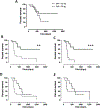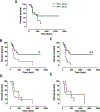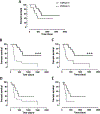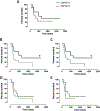Prolongation of survival of dogs with oral malignant melanoma treated by en bloc surgical resection and adjuvant CSPG4-antigen electrovaccination
- PMID: 27146852
- PMCID: PMC8668196
- DOI: 10.1111/vco.12239
Prolongation of survival of dogs with oral malignant melanoma treated by en bloc surgical resection and adjuvant CSPG4-antigen electrovaccination
Abstract
Reported post-surgery 1-year survival rate for oral canine malignant melanoma (cMM) is around 30%; novel treatments are needed as the role of adjuvant chemotherapy is unclear. This prospective study regards adjuvant electrovaccination with human chondroitin sulfate proteoglycan-4 (hCSPG4)-encoded plasmid in 23 dogs with resected II/III-staged CSPG4-positive oral cMM compared with 19 dogs with resected only II/III-staged CSPG4-positive oral cMM. Vaccination resulted in 6-, 12-, 18- and 24-month survival rate of 95.6, 73.9, 47.8 and 30.4%, respectively [median survival time (MST) 684 days, range 78-1694, 8 of 23 dogs alive] and 6-, 12-, 18- and 24-month disease-free interval (DFI) rate of 82.6, 47.8, 26.1 and 17.4%, respectively (DFI 477 days, range 50-1694). Non-vaccinated dogs showed 6-, 12-, 18- and 24-month survival rate of 63.2, 26.3, 15.8 and 5.3%, respectively (MST 200 days, range 75-1507, 1 of 19 dogs alive) and 6-, 12-, 18- and 24-month DFI rate of 52.6, 26.3, 10.5 and 5.3%, respectively (DFI 180 days, range 38-1250). Overall survival and DFI of vaccinated dogs was longer in those <20 kg. In vaccinated and non-vaccinated dogs local recurrence rate was 34.8 and 42%, respectively while lung metastatic rate was 39 and 79%, respectively.
Keywords: CSPG4; DNA electroporation; adjuvant immunotherapy; canine oral malignant melanoma; comparative oncology.
© 2016 John Wiley & Sons Ltd.
Figures






Similar articles
-
CSPG4-specific immunity and survival prolongation in dogs with oral malignant melanoma immunized with human CSPG4 DNA.Clin Cancer Res. 2014 Jul 15;20(14):3753-62. doi: 10.1158/1078-0432.CCR-13-3042. Epub 2014 May 29. Clin Cancer Res. 2014. PMID: 24874834 Free PMC article.
-
Clinical evaluation of HuDo-CSPG4 DNA electroporation as adjuvant treatment for canine oral malignant melanoma: comparison of two vaccination protocols.Vet Q. 2025 Dec;45(1):1-16. doi: 10.1080/01652176.2025.2473717. Epub 2025 Mar 10. Vet Q. 2025. PMID: 40059815 Free PMC article.
-
Difference in outcome between curative intent vs marginal excision as a first treatment in dogs with oral malignant melanoma and the impact of adjuvant CSPG4-DNA electrovaccination: A retrospective study on 155 cases.Vet Comp Oncol. 2021 Dec;19(4):651-660. doi: 10.1111/vco.12690. Epub 2021 Mar 22. Vet Comp Oncol. 2021. PMID: 33751759 Free PMC article.
-
Cancer immunology and canine malignant melanoma: A comparative review.Vet Immunol Immunopathol. 2016 Jan;169:15-26. doi: 10.1016/j.vetimm.2015.11.003. Epub 2015 Dec 1. Vet Immunol Immunopathol. 2016. PMID: 26827834 Review.
-
Canine oral melanoma.Clin Tech Small Anim Pract. 2007 May;22(2):55-60. doi: 10.1053/j.ctsap.2007.03.004. Clin Tech Small Anim Pract. 2007. PMID: 17591290 Review.
Cited by
-
The diagnostic yield of preoperative screening for oral cancer in dogs over 15 years, part 2: distant screening.J Am Vet Med Assoc. 2023 Sep 29;261(S2):S24-S33. doi: 10.2460/javma.23.05.0300. Print 2023 Dec 1. J Am Vet Med Assoc. 2023. PMID: 37770015 Free PMC article.
-
Strengths and Weaknesses of Pre-Clinical Models for Human Melanoma Treatment: Dawn of Dogs' Revolution for Immunotherapy.Int J Mol Sci. 2018 Mar 10;19(3):799. doi: 10.3390/ijms19030799. Int J Mol Sci. 2018. PMID: 29534457 Free PMC article. Review.
-
Cancer-Immunity Cycle and Therapeutic Interventions- Opportunities for Including Pet Dogs With Cancer.Front Oncol. 2021 Nov 19;11:773420. doi: 10.3389/fonc.2021.773420. eCollection 2021. Front Oncol. 2021. PMID: 34869014 Free PMC article. Review.
-
Electroporation-Based Treatments in Small Animal Veterinary Oral and Maxillofacial Oncology.Front Vet Sci. 2020 Sep 29;7:575911. doi: 10.3389/fvets.2020.575911. eCollection 2020. Front Vet Sci. 2020. PMID: 33134356 Free PMC article. Review.
-
A chimeric human/dog-DNA vaccine against CSPG4 induces immunity with therapeutic potential in comparative preclinical models of osteosarcoma.Mol Ther. 2023 Aug 2;31(8):2342-2359. doi: 10.1016/j.ymthe.2023.06.004. Epub 2023 Jun 12. Mol Ther. 2023. PMID: 37312451 Free PMC article.
References
-
- Liptak JM and Lascelles BDX. Oral tumors. In: Veterinary Surgical Oncology. Kidnig ST and Séguin B Eds., Ames, Wiley-Blackwell, 2012: 119–177.
-
- Liptak JM and Withrow SJ. Oral tumors. In: Small Animal Clinical Oncology. Withrow SJ, Vail DM and Page RL Eds., St. Louis, Elsevier, 2013: 381–398.
-
- Bergman PJ, Kent MS and Farese J. Melanoma. In: Withrow & MacEwen’s Small Animal Clinical Oncology. 5th edn., Withrow SJ, Vail DM and Page RL Eds., St. Louis, Sounders, 2013.
-
- Smedley RC, Lamoureux J, Sledge DG and Kiupel M. Immunohistochemical diagnosis of canine oral amelanotic melanocytic neoplasms. Veterinary Pathology 2011; 48: 32–40. - PubMed
-
- Ramos-Vara JA, Beissenherz ME, Miller MA, Johnson GC, Pace LW, Fard A, et al. Retrospective study of 338 canine oral melanomas with clinical, histologic, and immunohistochemical review of 129 cases. Veterinary Pathology 2000; 37: 597–608. - PubMed
MeSH terms
Substances
Grants and funding
LinkOut - more resources
Full Text Sources
Other Literature Sources
Medical
Research Materials

